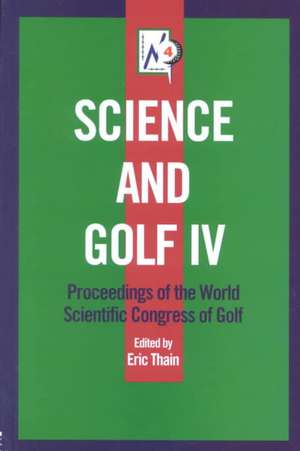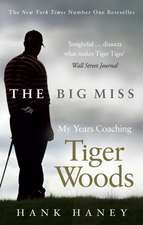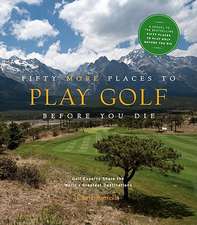Science and Golf IV
Editat de Eric Thainen Limba Engleză Hardback – 18 iul 2002
The book is organised into four thematic sections, looking at the golfer, golf equipment, the golf course, and the social and economic impact of golf respectively, and addresses key topics such as:
* the psychology of golf
* biometrics of the swing
* new developments in clubs, balls and teaching aids
* golf agronomy, irrigation and drainage
* the impact of golf on the community
* representing the most up-to-date collection of research available.
Science and Golf IV is essential reading for all sport scientists and researchers with an interest in golf, all club professionals, and all those working in technical aspects of the golf industry.
| Toate formatele și edițiile | Preț | Express |
|---|---|---|
| Paperback (1) | 317.65 lei 6-8 săpt. | |
| Taylor & Francis – 29 noi 2011 | 317.65 lei 6-8 săpt. | |
| Hardback (1) | 1369.55 lei 6-8 săpt. | |
| Taylor & Francis – 18 iul 2002 | 1369.55 lei 6-8 săpt. |
Preț: 1369.55 lei
Preț vechi: 1830.96 lei
-25% Nou
Puncte Express: 2054
Preț estimativ în valută:
262.10€ • 272.62$ • 216.38£
262.10€ • 272.62$ • 216.38£
Carte tipărită la comandă
Livrare economică 14-28 aprilie
Preluare comenzi: 021 569.72.76
Specificații
ISBN-13: 9780415283021
ISBN-10: 0415283027
Pagini: 874
Dimensiuni: 156 x 234 x 53 mm
Greutate: 1.61 kg
Ediția:1
Editura: Taylor & Francis
Colecția Routledge
Locul publicării:Oxford, United Kingdom
ISBN-10: 0415283027
Pagini: 874
Dimensiuni: 156 x 234 x 53 mm
Greutate: 1.61 kg
Ediția:1
Editura: Taylor & Francis
Colecția Routledge
Locul publicării:Oxford, United Kingdom
Cuprins
1: The Golfer; 1: A Spatial Model of the Rigid-Body Club Swing; 2: Biomechanical Analysis of Professional Golfer's Swing; 3: Age, Centre of Pressure and Clubhead Speed in Golf; 4: Effect of Muscle Strength and Flexibility on Club-Head Speed in Older Golfers; 5: Maximal Static Contraction Strengthening Exercises and Driving Distance; 6: Bone Mass, Bone Mineral Density and Muscle Mass in Professional Golfers; 7: Strength Training and Injury Prevention for Professional Golfers; 8: Comparison of Spine Motion in Elite Golfers with and without Low Back Pain; 9: Musculoskeletal Injury Questionnaire for Senior Golfers; 10: A Critical Examination of Motor Control and Transfer Issues in Putting; 11: Experimental Study of Effects of Distance, Slope and Break on Putting Performance for Active Golfers; 12: Is it a Pendulum, is it a Plane?— Mathematical Models of Putting; 13: Putting Alignment in Golf; 14: Eye Dominance, Visibility, and Putting Performance; 15: Alignment Variations among Junior Golfers; 16: The Effects of Outcome Imagery on Golf-Putting Performance; 17: The Efficacy of Video Feedback for Learning the Golf Swing; 18: The Role of Metaphor in Expert Golf Instruction; 19: Golf Their Way; 20: An Analysis of an Effective Golf Teacher Education Program; 21: Why Does Traditional Training Fail to Optimize Playing Performance?; 22: Performance and Practice of Elite Women European Tour Golfers During a Pressure and a Non-Pressure Putting Simulation; 23: Practice for Competition in Women Professional Golfers; 24: Yielding to Internal Performance Stress? – The Yips in Golf; 25: The Golfer-Caddie Partnership; 26: A General Principle in Golf; 27: Team Selection by Portfolio Optimization; 2: The Equipment; 28: Compression by Any Other Name; 29: Effects of Dimple Design on the Aerodynamic Performance of a Golf Ball; 30: A Generally Applicable Model for the Aerodynamic Behavior of Golf Balls; 31: 3-Dimensional Trajectory Analysis of Golf Balls; 32: The Vibrational Mode Structure of a Golf Ball; 33: On the Acoustic Signature of Golf Ball Impact; 34: Measurement of the Behavior of a Golf Club During the Golf Swing; 35: On Measuring the Flexural Rigidity Distribution of Golf Shafts; 36: Characteristic Spring Constants for Golf Club Heads; 37: Influence of Characteristics of Golf Club Head on Release Velocity and Spin Velocity of Golf Ball after Impact; 38: Optimization of Golf Club Face for Enhancement of Coefficient of Restitution; 39: High Performance Driver Design; 40: Experiments in Golf Ball; 41: Development and Use of One-Dimensional Models of a Golf Ball; 42: Clubhead Acceleration Patterns during Impact with the Golf Ball; 43: Mapping Clubhead to Ball Impact and Estimating Trajectory; 44: Is the Impact of a Golf Ball Hertzian?; 45: An Extended Model of Oblique Impact of Elastic Ball; 46: Experimental Determination of Apparent Contact Time in Normal Impact; 47: An Investigation into the Effect of the Roll of a Golf Ball Using the C-Groove Putter; 3: The Golf Course; 48: Evaluation of New Cultivars for Putting Greens in the U.S.; 49: Root Distribution and ET as Related to Drought Avoidance in Poa Pratensis; 50: Intraspecies Wear Stress Tolerance Investigations with Poa Pratensis; 51: Transformation of Herbicide Tolerant and Disease Resistant Creeping Bentgrass; 52: Relative Performance of Bentgrass Species and Cultivars During Golf Buggy Wear; 53: Physiological Responses of Agrostis palustris L. to Lowering Day or Night Soil Temperatures Under Heat Stress; 54: Effects of Syringing on Summer Stress Performance of Creeping Bentgrass (Agrostis stolonifera L); 55: Reduced Rate Preemergence Herbicide Programs for Digitaria Ischaemum Control in Bermudagrass Turf; 56: Conventional and Innovative Methods for Fairy Ring Management in Turfgrass; 57: Competition between Agrostis Stolonifera and Poa annua Populations in Turfgrass Communities; 58: The Use of Plant Growth Regulators to Reduce Poa annua ssp. Annua in Bentgrass Putting Greens; 59: Growth Retardants Alter Expansive Growth and Establishment of Cynodon sp.; 60: Potassium Nutrition Effects on Agrostis stolonifera L. Wear Stress Tolerance; 61: Sulfur Level and Timing Effects on Agrostis Palustris Injury and Soil pH; 62: Dislodgeable Residues of 2,4-D and Implications for Golfer Exposure; 63: Effect of Thatch on Pesticide Model Leaching Predictions; 64: Diurnal and Temporal Variations of Green Speed; 65: Can Golf Courses Enhance Local Biodiversity?; 66: Heathland Invertebrates on Golf Courses; 67: An Improved Apparatus and Technique for Measuring Green-Speed; 4: Golf Development; 68: Golf Participation Growth Feasibility Assessment; 69: Golf Potential in Germany in the International Context; 70: Complementing Touristic Development with Popular Recreation; 71: An Analysis of Alternative Golf Facilities and their Relation to Traditional Golf; 72: An Examination of Fan Motivation Among Men and Women Spectators Attending an LPGA Tour Event; 73: Economic Contribution of Golf to the UK Economy; 74: Appraising Golf Developments in the Era of ‘Contested Countrysides'; 75: Understanding Nostalgia Sport Tourism
Descriere
Representing the most up-to-date collection of research available, an essential read for all sport scientists and researchers with an interest in golf, all club professionals, and all those working in technical aspects of the golf industry.


















